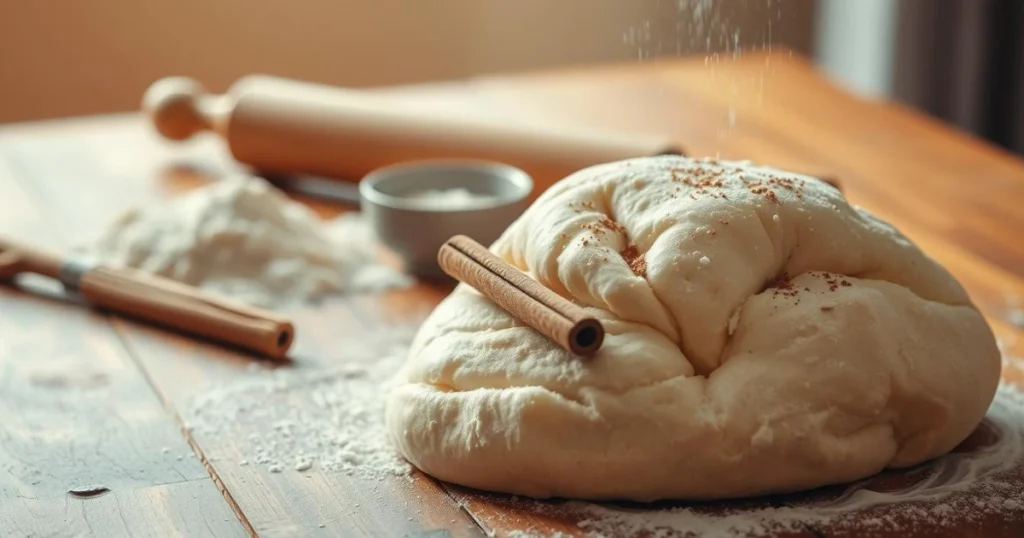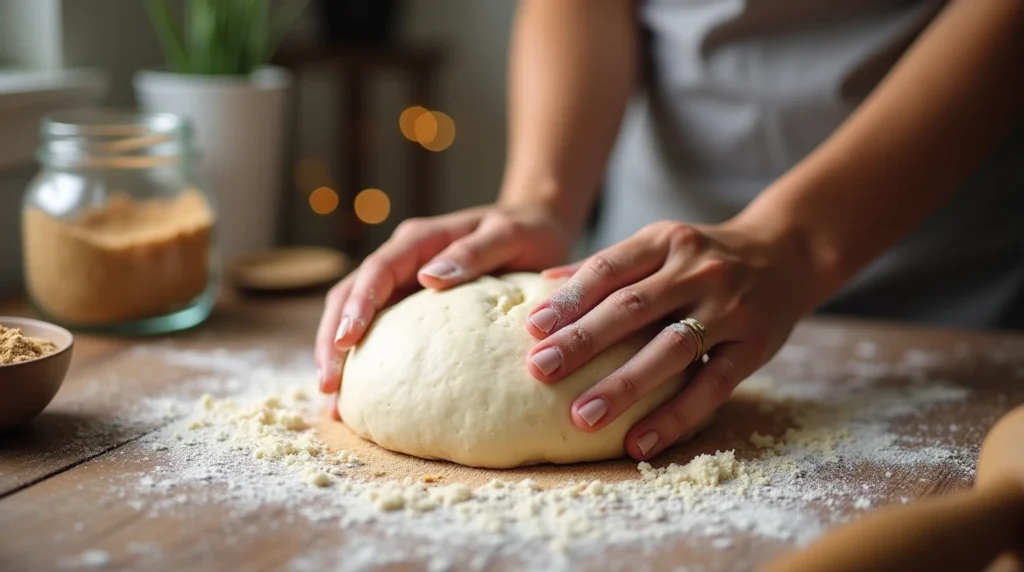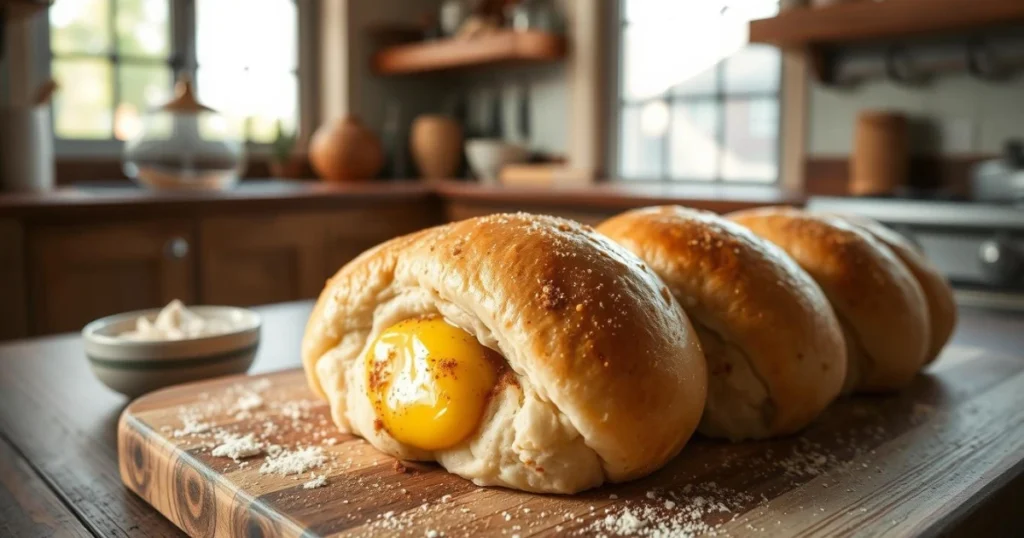Every kitchen has its special moment. For me, it’s when the smell of Sourdough Cinnamon Rolls Recipe fills the air. It’s a moment of pure joy, waiting to pull apart those warm, gooey layers.
These rolls are more than just treats. They mix the tangy taste of sourdough with the sweet warmth of cinnamon. Each bite is a story of patience, skill, and love.

Whether you’re an experienced baker or new to sourdough, this recipe will make your kitchen a place of joy. Get ready for a baking adventure that will delight your senses and impress your guests.
Try our Sourdough Donuts for another tangy treat!
Table of Contents
The Perfect Balance of Tangy and Sweet
Making this recipe turns a simple breakfast into a work of art. These rolls have a unique flavor that stands out from regular recipes. The secret is in the fermentation and the special qualities of sourdough.
Understanding Sourdough’s Role
Sourdough starter is more than just a helper. It’s a mix of wild yeasts and good bacteria that make the rolls taste amazing. The fermentation process breaks down carbs, making the rolls soft and tangy.
- Enhances digestibility
- Develops complex flavor
- Creates a lighter texture
- Adds natural depth to the rolls
What Makes overnight sourdough cinnamon rolls Special
Unlike rolls made with commercial yeast, sourdough cinnamon rolls have a richer taste. The slow fermentation lets flavors grow, making the pastry more complex and exciting.
| Characteristic | Sourdough Cinnamon Rolls | Traditional Rolls |
|---|---|---|
| Flavor Complexity | Deep, Tangy | Simple, Sweet |
| Texture | Soft, Airy | Dense, Uniform |
| Digestibility | Easier to Digest | Standard Digestion |
Key Flavor Components
The secret to amazing cinnamon rolls is finding the right mix of tangy and sweet. Wild yeasts and bacteria in the sourdough starter add a subtle tang. This balances the sweet filling, creating a perfect pastry that’s hard to resist.
“Sourdough transforms simple ingredients into a culinary symphony of flavor and texture.” – Artisan Baker’s Wisdom
Essential Ingredients for Fluffy Sourdough Cinnamon Rolls Recipe
Starting with the right ingredients is crucial to baking fluffy sourdough cinnamon rolls that are soft, flavorful, and perfectly risen. The quality of your sourdough breakfast rolls depends on the ingredients you choose. Below are the must-have ingredients to ensure your baking success.
Dry Ingredients for Sourdough Cinnamon Rolls
• All-purpose flour (or bread flour for chewier texture)
• Granulated sugar
• Salt
• Ground cinnamon (preferably fresh, high-quality like Saigon cinnamon)
Wet Ingredients for Soft Sourdough Dough
• Active sourdough starter (bubbly and recently fed for best rise and tang)
• Whole milk (room temperature)
• Large eggs (room temperature)
• Unsalted butter (melted and cooled)
Pro Tip: Use organic ingredients when possible to boost the flavor of your overnight sourdough cinnamon rolls.
Filling and Frosting Essentials for Irresistible Cinnamon Rolls
• Brown sugar (light or dark packed)
• Softened butter
• Cream cheese (for rich, tangy frosting)
• Powdered sugar (for smooth icing)
• Vanilla extract (for aroma and flavor depth)
Flavor Tip: Vietnamese or Saigon cinnamon adds a deeper, spicier flavor that makes your easy sourdough cinnamon rolls with cream cheese frosting unforgettable.
Mastering the Sourdough Starter Preparation for Perfect Cinnamon Rolls
Your sourdough starter is the heart of the dough, providing rise, flavor, and texture. A vibrant, active starter is essential for making the best sourdough cinnamon rolls.
Feeding Schedule for an Active Sourdough Starter
• Feed your starter daily at the same time
• Use equal parts flour and water by weight
• Discard half the starter before each feeding
• Keep the starter at a consistent room temperature (around 70-75°F)
How to Test Starter Readiness
- Float Test: Drop a spoonful of starter in water-if it floats, it’s ready.
- Look for significant bubbling and doubling in size.
- Smell for a pleasant, slightly tangy aroma.
- Ensure the starter doubles in volume within 4-6 hours after feeding.
Troubleshooting Common Starter Issues
- If sluggish, adjust temperature, hydration, and feeding frequency.
- Be patient-consistent care improves starter activity over time.
Pro Tip: A well-maintained starter is key to achieving fluffy, tangy sourdough cinnamon rolls that rise beautifully.
Creating the Perfect Dough Base

Your cinnamon rolls start with the right mix of ingredients and techniques. These steps turn simple parts into a soft, fluffy treat.
Your dough’s foundation is important. The sourdough starter adds flavor and texture. Make sure your starter is active and bubbly for the best taste.
- Use high-protein bread flour for optimal gluten development
- Maintain consistent dough temperature between 75-80°F
- Knead until the dough becomes smooth and elastic
Dough proofing needs patience and care. This step lets your sourdough develop flavors and become light. Kneading helps create the soft structure of your rolls.
| Ingredient | Purpose | Recommended Quantity |
|---|---|---|
| Bread Flour | Provides protein for gluten structure | 4 cups |
| Active Sourdough Starter | Adds flavor and helps rise | 1 cup |
| Butter | Adds richness and tenderness | 1/2 cup |
Look for these signs of perfect dough: it should feel smooth and spring back. It should also stretch without tearing. Don’t overwork the dough to avoid tough rolls.
Tip: The secret to amazing cinnamon rolls is understanding your dough’s unique characteristics and treating it with care.
Crafting the Irresistible Cinnamon Filling
Your cinnamon filling is the heart of these tasty rolls. It’s all about finding the right balance of flavors. You want every bite to be full of deliciousness.
Measuring Perfect Proportions
For a top-notch filling, get the ingredient ratios right:
- 1/2 cup softened butter
- 3/4 cup dark brown sugar
- 2-3 tablespoons ground cinnamon
- Optional: 1/4 teaspoon salt to enhance flavors
Achieving the Ideal Spread
Spreading the cinnamon mixture needs skill. Make sure your butter is soft. Use a spatula or the back of a spoon to spread it evenly. Leave a small border around the edges.
Enhancing Flavor Profiles
To take your rolls to the next level, try these:
- Sprinkle chopped pecans for crunch
- Add a dash of vanilla extract
- Incorporate finely grated orange zest
- Drizzle a thin layer of honey
The secret to recipe is in the filling details. Experiment to find the perfect mix that makes your taste buds happy!
Rolling and Shaping Techniques
Turning your sourdough starter into beautiful cinnamon rolls needs skill. The rolling and shaping steps are key for those perfect swirls. They make your mouth water just thinking about them.

First, dust your work surface with flour. Roll out your sourdough dough into a rectangle. Aim for even thickness so your cinnamon and butter filling spreads well.
- Use a ruler to help create a precise rectangle
- Roll the dough to about 1/4 inch thickness
- Ensure the surface is evenly covered with flour
When adding cinnamon filling, leave a small border around the edges. This prevents overflow. Sprinkle sugar evenly across the dough for a sweet base.
| Shaping Technique | Key Tips |
|---|---|
| Rolling Method | Start from the long edge, roll tightly to create consistent swirls |
| Cutting Technique | Use dental floss or a sharp knife for clean, even cuts |
Pro tip: For uniform rolls, measure and mark your dough before cutting. A sharp knife or dental floss helps make clean cuts. This way, you avoid squishing the dough.
The secret to perfect cinnamon rolls lies in the careful balance of technique and patience.
Your aim is to make rolls that look visually stunning and taste amazing. Take your time, handle the dough gently, and enjoy making these tasty treats.
Proofing and Rising Guidelines
Getting the proofing right is key to making your sourdough cinnamon rolls light and fluffy. The rising stages affect the texture and taste of your treat. Yeast is essential for the perfect rise, turning your dough into a soft, airy delight.
First Rise Tips
The first rise starts after mixing the dough. Here’s how to help your sourdough grow:
- Use a warm, draft-free space around 75-80°F
- Cover the dough with a damp cloth to prevent drying
- Look for the dough to double in size (typically 4-6 hours)
Second Rise Secrets
The second rise happens after shaping your rolls. It’s vital for the incredible texture and getting ready for baking:
- Shape rolls gently to maintain air pockets
- Let rolls rest in a warm environment
- Proof until rolls are puffy and touching
Temperature Control Methods
Keeping the temperature steady is crucial for perfect rising. Try these methods:
- Use a proofing box for precise temperature control
- Place dough near a warm oven (but not too hot)
- Monitor humidity to prevent surface drying
Your cream cheese frosting will be even more delicious when your rolls are perfectly proofed!
Baking Methods for Perfect Results

To get perfect fluffy sourdough cinnamon rolls, you need precision and to know your baking techniques. Your sourdough breakfast rolls need careful attention during baking. This ensures they turn out golden and delicious.
Temperature and timing are key when baking your cinnamon roll glaze-topped treats. Preheat your oven to 375°F for a great baking experience. Here are the essential steps for success:
- Place rolls in a well-greased baking pan, leaving slight space between each
- Position the pan in the center of the oven for even heat distribution
- Rotate the pan halfway through baking to prevent uneven browning
- Check internal temperature with an instant-read thermometer
Baking time is usually 20-25 minutes. Look for a light golden-brown color to know they’re done. The internal temperature should be between 190-200°F. This ensures they’re fully baked without drying out.
Dealing with common baking problems can make your sourdough breakfast rolls amazing. Watch for signs of underbaking, like pale or doughy centers. Adjust your technique as needed.
Pro tip: Every oven is unique. Get to know your specific appliance’s quirks to master the art of baking fluffy cinnamon rolls.
The right baking method turns your sourdough creation into a mouthwatering treat. It will impress your family and friends.
Cream Cheese Frosting Excellence
Your homemade cinnamon rolls need a luxurious cream cheese frosting. This topping makes them go from good to amazing.
Making the best cream cheese frosting is all about precision and quality. You need to balance the flavors and get it smooth and spreadable.
Essential Ingredients
- Softened cream cheese
- Unsalted butter
- Powdered sugar
- Pure vanilla extract
- Pinch of salt
Frosting Technique
For the best results, frost your cinnamon rolls when they’re still warm. This lets the frosting melt a bit, making a rich glaze that fills every crevice.
| Ingredient | Quantity | Purpose |
|---|---|---|
| Cream Cheese | 8 oz | Creamy base |
| Butter | 1/4 cup | Richness |
| Powdered Sugar | 2 cups | Sweetness |
| Vanilla Extract | 1 tsp | Flavor depth |
“The secret to perfect cream cheese frosting is letting ingredients reach room temperature before mixing.” – Pastry Chef Recommendation
Pro tip: Whip the frosting until it’s light and fluffy. This makes a topping that melts in your mouth. Your sourdough cinnamon rolls will love you for it!
🍽️ Related Recipes You’ll Love
If you enjoyed this Sourdough Cinnamon Rolls Recipe, check out these other delicious treats:
- Cinnamon Rolls with Heavy Cream – Extra gooey and rich, thanks to the heavy cream poured over before baking.
- Banana Bread – Moist, flavorful, and a classic way to use up ripe bananas!
- the best apple pie recipe with a perfectly flaky crust and sweet filling.
Making the best cinnamon rolls with sourdough is more than baking. It’s an art that connects you to old baking ways. Your homemade sourdough cinnamon rolls are a journey of taste, texture, and skill. They turn simple ingredients into a special breakfast treat.
This easy cinnamon rolls method teaches you to make a tangy, gooey masterpiece. The beauty of sourdough cinnamon rolls is their flexibility. You can keep them at room temperature for up to 3 days or refrigerate them for a week. This way, you can enjoy them for a long time.
As you keep baking with sourdough, remember each batch is a chance to get better. Try different fillings, change spice levels, and make it your own. The fun of baking is in being creative and sharing warm, fresh rolls with others.
Your sourdough adventure is just starting. Enjoy the process, learn from each bake, and savor the tasty results of your journey.
FAQ
What makes sourdough cinnamon rolls different from traditional cinnamon rolls?
Sourdough cinnamon rolls have a tangy flavor from the sourdough starter’s fermentation. This process adds depth and complexity to the taste. It also makes the rolls softer and more tender than traditional yeast-based ones.
How long does it take to make sourdough cinnamon rolls from start to finish?
Making sourdough cinnamon rolls takes about 12-16 hours. This includes starter preparation, dough making, proofing, and baking. Most of this time is spent waiting for the dough to rise, so you’ll only work for a few hours.
Can I make sourdough cinnamon rolls without a sourdough starter?
You can make a quick substitute using yeast and yogurt or buttermilk. But, using a mature sourdough starter gives a more authentic taste.
How do I know if my sourdough starter is ready to use?
A ready starter doubles in size in 4-8 hours after feeding. It should smell slightly sour and have lots of bubbles. It should also pass the “float test” – a spoonful floats in water.
Can I prepare sourdough cinnamon rolls in advance?
Yes! You can prepare the dough up to the final shaping and refrigerate it. In the morning, let it rise before baking. Or, bake and freeze them for up to a month.
What type of flour works best for easy sourdough cinnamon rolls?
Bread flour is best because it has more protein. This helps the dough become elastic and soft. You can also mix in all-purpose flour or whole wheat for extra nutrition.
How can I prevent my cinnamon rolls from becoming dry?
To keep rolls moist, don’t overbake and ensure the dough is well-hydrated. Use the right amount of liquid and don’t add too much flour. Check them early and cover with foil if needed.
Can I make these cinnamon rolls dairy-free or vegan?
Yes, use plant-based milk and coconut oil or vegan butter. For the frosting, use cashew cream or vegan cream cheese. The sourdough base stays the same.
How should I store leftover sourdough cinnamon rolls?
Store them in an airtight container at room temperature for 2-3 days. For longer storage, refrigerate or freeze. Reheat gently to restore their softness.
Why did my cinnamon rolls turn out dense and heavy?
Dense rolls often come from under-proofed dough or inactive starter. Make sure your starter is active and knead the dough well. Give it enough time to rise for light, fluffy rolls.
Best Recipe for Heavenly Hash Brownies – Fudgy, Nutty & Irresistible
Try this recipe for heavenly hash brownies—fudgy, nutty, and loaded with marshmallows. A rich treat everyone will love!
Healthy Turkey Quinoa Meatloaf – Moist, Flavorful & Easy to Make
Discover how to make a delicious turkey quinoa meatloaf that’s both healthy and satisfying. Perfect for family dinners
Irresistible Sourdough Cinnamon Rolls Recipe – Warm, Gooey, and Delicious
Make the best sourdough cinnamon rolls at home – soft, fluffy, and gooey with a sweet cinnamon swirl. Perfect for breakfast or dessert!



